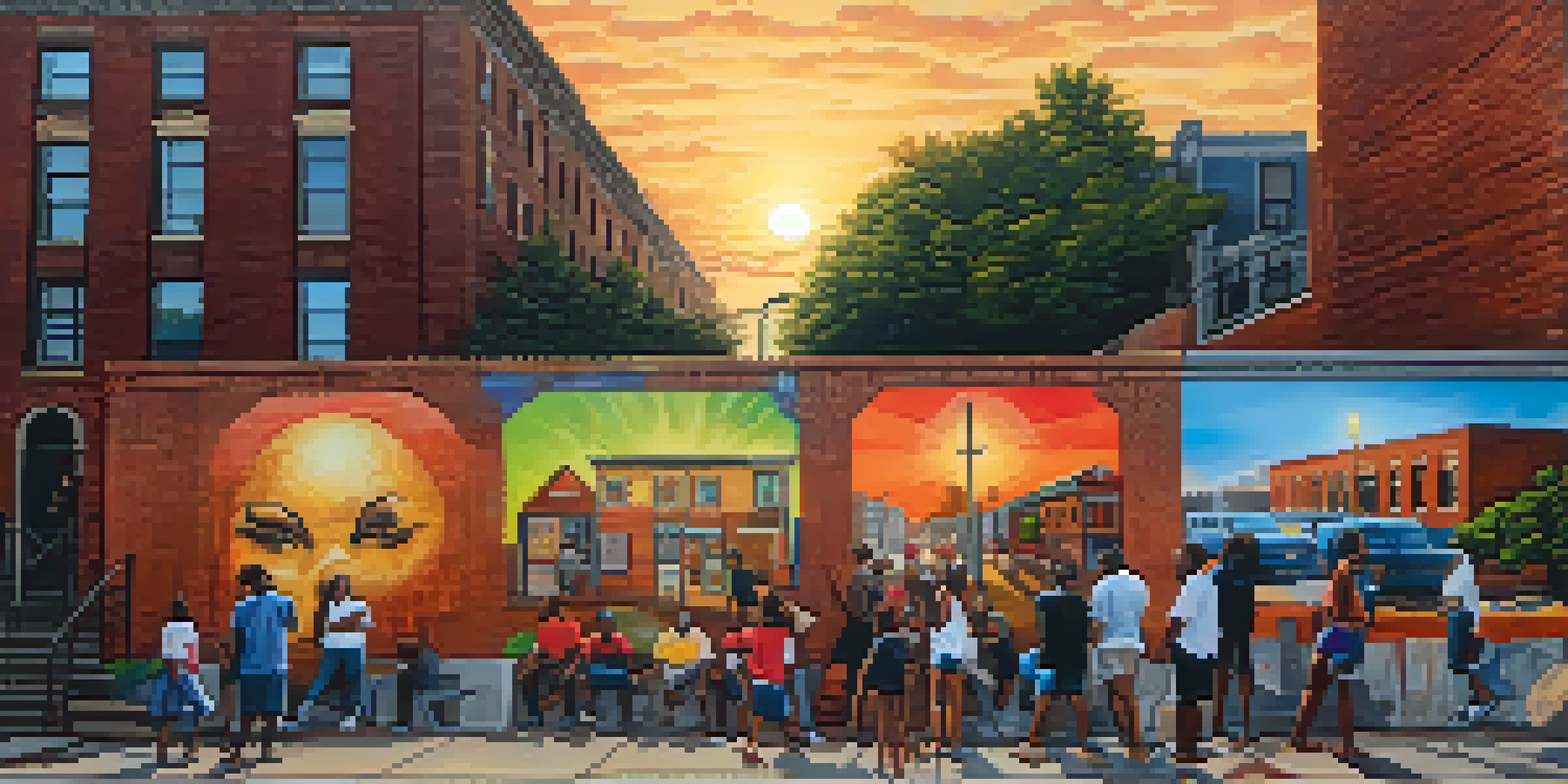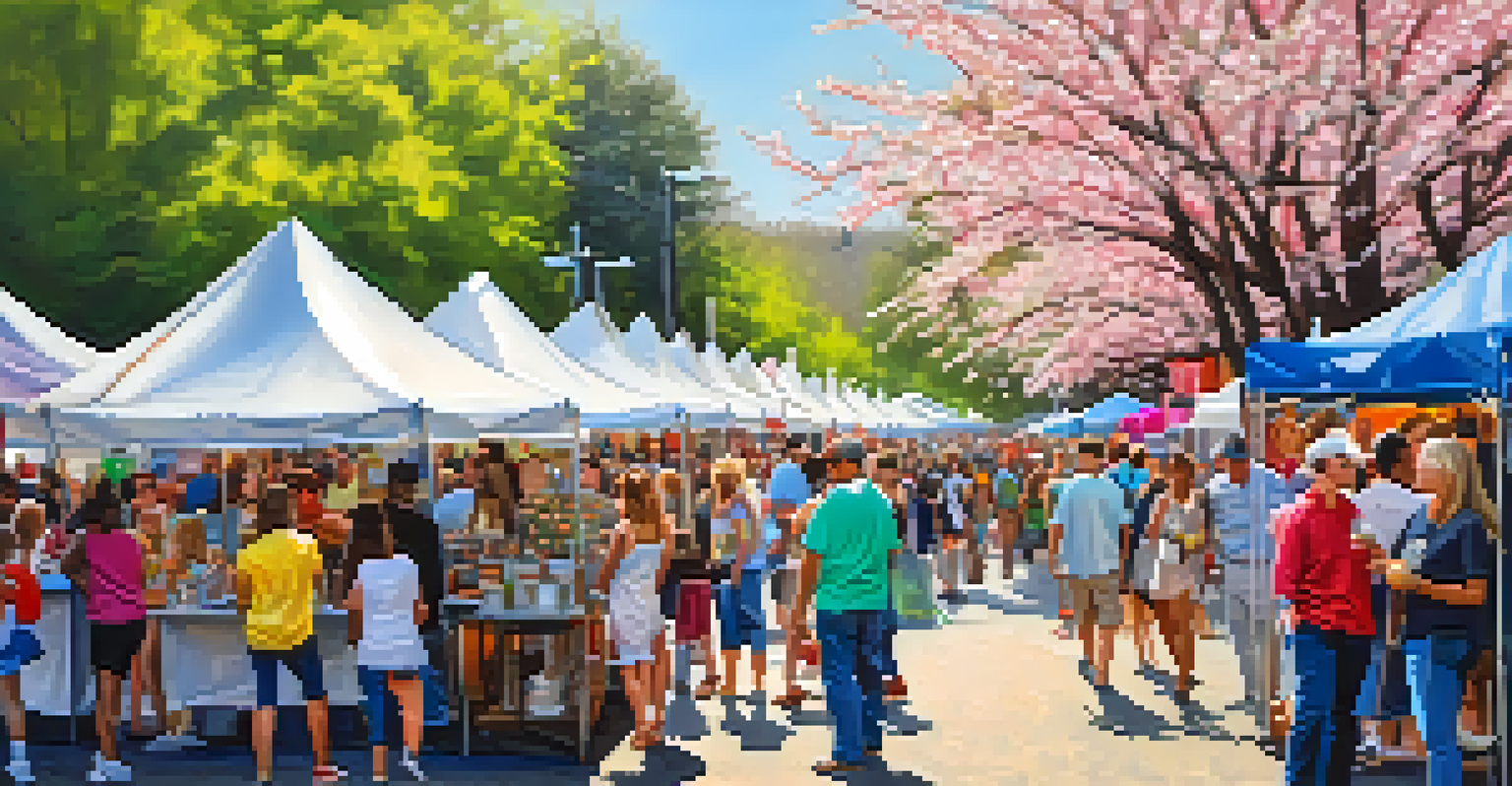Atlanta's Art Scene: A Hub for Contemporary Artists Today

A Brief History of Atlanta's Art Scene
Atlanta's art scene has evolved dramatically over the years, from its roots in the Civil Rights Movement to its current status as a contemporary art hub. The city's rich history has shaped its cultural landscape, providing a backdrop for artistic expression and innovation. As artists began to emerge, they found inspiration in Atlanta's unique blend of Southern tradition and modern urban life.
Art is not what you see, but what you make others see.
In the 1990s, Atlanta experienced an art renaissance, with the establishment of galleries and art collectives that showcased local talent. This period marked a shift in how art was perceived and appreciated in the city, paving the way for contemporary artists to explore new mediums and themes. The growth of institutions like the High Museum of Art further fueled this creative explosion, attracting both local and national artists.
Today, Atlanta is known for its vibrant art community, which includes not only established artists but also emerging talents. The city hosts numerous art festivals, exhibitions, and events that celebrate creativity and diversity, making it an inviting space for artists from various backgrounds.
Key Art Districts in Atlanta
Atlanta boasts several key art districts that contribute to its dynamic art scene. One of the most popular is the Old Fourth Ward, which has transformed from a historical neighborhood into a thriving cultural center. Here, you can find galleries, studios, and public art installations that reflect the community's diverse artistic voices.

Another notable area is Castleberry Hill, known for its vibrant street art and creative spaces. This historic neighborhood is home to many artists and hosts the popular monthly Art Stroll, where locals and visitors can explore galleries and meet artists. This communal atmosphere encourages collaboration and fosters a sense of belonging among artists and art lovers alike.
Atlanta's Art Scene Evolution
Atlanta's art scene has transformed from its historical roots in the Civil Rights Movement to a vibrant contemporary art hub.
Midtown is also a significant player in Atlanta's art scene, featuring the Arts District and a variety of cultural institutions. The presence of the Fox Theatre and the Woodruff Arts Center attracts a diverse audience, making it a hub for both performing and visual arts. These districts collectively contribute to the city's reputation as a contemporary art destination.
Prominent Contemporary Artists in Atlanta
Atlanta is home to many contemporary artists who are making waves both locally and nationally. Artists like Radcliffe Bailey and Fahamu Pecou explore themes of identity, history, and culture through their work, often drawing from their own personal experiences. Their unique perspectives resonate with audiences, sparking conversations around race, heritage, and community.
Every artist was first an amateur.
Emerging artists such as Molly Rose Freeman and Nick Cave are also contributing to Atlanta's contemporary art landscape. Freeman's colorful murals and Cave's striking sound suits invite viewers to engage with their art on a deeper level. These artists, along with others, are pushing boundaries and redefining what it means to be an artist in today's world.
The support for artists in Atlanta is evident through various initiatives and programs aimed at nurturing talent. Organizations like the Atlanta Contemporary and The Goat Farm Arts Center provide platforms for artists to showcase their work and connect with the community, ensuring that the city's art scene continues to thrive.
Art Festivals and Events in Atlanta
Atlanta hosts a plethora of art festivals and events that celebrate creativity and community engagement. One of the largest is the Atlanta Dogwood Festival, which features local artists, musicians, and food vendors, drawing thousands of visitors each year. This festival not only showcases visual arts but also emphasizes the importance of community and collaboration.
Another highlight is the Atlanta Contemporary Art Center's annual event, 'Art on the Atlanta BeltLine,' which transforms the city's BeltLine into an open-air gallery. This event features a range of artworks, from installations to performances, encouraging public interaction and appreciation for the arts. It serves as a reminder of how art can be woven into the fabric of everyday life.
Key Art Districts Enrich Culture
The city's key art districts, such as Old Fourth Ward and Castleberry Hill, contribute significantly to its dynamic and diverse artistic culture.
Additionally, the Atlanta Film Festival showcases the intersection of visual arts and storytelling, offering a platform for filmmakers and artists alike. These events foster a sense of belonging and inspire collaboration, making Atlanta a vibrant hub for contemporary artists and art enthusiasts.
The Role of Galleries and Collectives
Galleries and art collectives play a crucial role in Atlanta's contemporary art scene, providing artists with spaces to exhibit their work and connect with the community. Institutions like the High Museum of Art and the Museum of Contemporary Art of Georgia are instrumental in promoting local talent and hosting important exhibitions. These venues not only showcase art but also offer educational programs and workshops for aspiring artists.
In addition to traditional galleries, artist-run collectives have emerged as vital spaces for experimentation and collaboration. Collectives like WonderRoot and the Goat Farm Arts Center foster a sense of community among artists, allowing them to share resources and ideas. This collaborative spirit enhances the creative process and encourages innovative approaches to art-making.
Moreover, these galleries and collectives often host events, such as openings and artist talks, which provide opportunities for engagement and discussion. By supporting local artists and creating platforms for dialogue, they contribute significantly to the growth and sustainability of Atlanta's art scene.
Art Education and Community Involvement
Art education is an essential component of Atlanta's creative ecosystem, with various institutions offering programs for all ages. From universities like Georgia State and SCAD to community art centers, these programs empower individuals to explore their creativity and develop their artistic skills. This emphasis on education ensures a steady flow of fresh talent into the local art scene.
Community involvement is equally important, with numerous initiatives aimed at bringing art to underserved neighborhoods. Programs like 'Art for All' focus on making art accessible to everyone, regardless of their background or financial situation. These efforts not only foster creativity but also promote social change and community cohesion.
Support for Emerging Artists
Various initiatives and organizations in Atlanta actively nurture emerging artists, ensuring the city's art scene continues to thrive.
Through partnerships with schools and local organizations, artists and educators work together to inspire the next generation of creatives. This commitment to art education and community engagement strengthens Atlanta's artistic identity, ensuring that the city remains a vibrant hub for contemporary art.
The Future of Atlanta's Art Scene
As Atlanta continues to grow and evolve, its art scene is poised for exciting developments. The city attracts a diverse group of artists, each bringing their unique backgrounds and perspectives to the table. This diversity not only enriches the local art environment but also ensures that Atlanta remains a relevant player in the contemporary art world.
Emerging technologies and new mediums are also influencing the direction of art in Atlanta. Artists are increasingly exploring digital platforms and interactive installations, pushing the boundaries of traditional art forms. This willingness to innovate and adapt is a hallmark of Atlanta's creative community, keeping it fresh and engaging.

Furthermore, as the city invests in public art and cultural initiatives, the future looks bright for Atlanta's art scene. With continued support for artists, galleries, and educational programs, Atlanta is set to thrive as a vibrant hub for contemporary artists, attracting visitors and art lovers from around the globe.